Default blocks for Gutenberg Editor in WordPress
Since its launch with WordPress 5.0, the Gutenberg Editor has transformed how we build and manage content. Known now simply as the “block editor” or “WordPress editor,” it’s a significant leap forward in terms of flexibility and functionality, offering a clean, developer-friendly, and distraction-free space to create content with ease.
In this guide, we’ll explore the essential blocks available in the Gutenberg editor, their functions, and how they can enhance your WordPress site.
Common Blocks
Paragraph
This is one of the Common Blocks in Gutenberg Editor. Press ‘Enter’ to create a new Paragraph Block. It splits your content into different blocks, and each paragraph block has its own independent settings. A paragraph block can be converted into other text blocks based on the curator’s choice and need.
1. Heading
2. Subheading
A subheading is a block that helps you describe and highlight a piece of text. It is usually placed after the heading tag, a little smaller than a heading but larger than normal paragraph content. A subheading block is used when a content structure needs to be broken down further to bring the desired outlook.
3. Image
A subheading is a block that helps you describe and highlight a piece of text. It is usually placed after the heading tag, a little smaller than a heading but larger than normal paragraph content. A subheading block is used when a content structure needs to be broken down further to bring the desired outlook.
4. Gallery
Gallery Block is one of the common blocks used. This block allows developers to add multiple images inside the page in a grid-like manner. Moreover, you also have the provision to edit the image caption and the number of grid columns as per your need.
5. Quote
6. List
The List Block in the Gutenberg Editor helps organize the content in the form of a list or bullet to describe the list of items in the content structure.
7. Cover Image
8. Video
The Video Block helps to add videos on the WordPress site and display them inside the post content. It is important to note that this video block is not intended for YouTube or Vimeo videos embedding, or other videos hosted on external services. WordPress also provides a different block for embedding videos from external sources.
9. Audio
Audio Block helps in adding audio files in the form of native and simple HTML audio player. It can be used to add and play audio files inside your content structure. These audio files are added and stored in the Media Library. Adding an audio file to your content makes your content a little interesting for the readers. Sometimes readers do not actually want to ‘read’ but prefer to listen to the file.
10. Formatting Blocks
Formatting blocks provide additional formatting options for your content post. From Code to verse to table to Custom HTML and more. Get special format blocks with Gutenberg block editor.
11. Pull Quote
Pull Quote is a Formatting Block that is similar to Quote Block but it makes the quote more prominent and larger.
12. Table
The Table block allows you to enter a table in your content of the post. Customize the alignment of the table along with the number of rows and columns.
13. Code
Want to display a code snippet to your WordPress site? Use the Code Blocks in the Gutenberg WordPress Editor from any programming language. It helps in preserving tabs and spaces. In this Code Blocks, you can also add additional formatting options like Bold, italics, and more.
14. Custom HTML
Custom HTML helps the developer to add Custom HTML code to the content of your post. The best part is that you can preview it instantly to have an idea of its Front-end appearance.
15. Verse
Are you into writing lyrics or paragraphs of songs in a professional way? Verse Block will help you write the different verses of your lyrics, poetry, and such in an appreciable manner. The line breaks and spaces are supposed to be left intact.
Layout Blocks
Separator
A simple horizontal line separator helps in differentiating sections of the content depending upon the content structure or framework.
More
Buttons
Columns
The Columns Block helps you split the content into multiple columns, and the maximum columns allowed are 6. You can also add more blocks inside the columns as you normally would do.
Text Columns
This is similar to the Columns Block, but you can only add text inside the columns. You do not have the liberty to add blocks in these Text column blocks.
Page Break
Page Break is another Block used for differentiating the sections of a post. You can have multiple page breaks. The reader will view “Next Page” and click on it to read through the rest of the post content. This is beneficial when creating a long article that needs a little breathing space for the clients to consume all the content.
Spacer
A spacer block also helps in adding separation to the content by adding a large rectangular shaped space between the two blocks in the post.
Widgets
Latest Post
Latest Post Widget is similar to the Recent Post Widgets as it provides a customized list of links to the most recent post on the WordPress site. You can change the number of posts, and their placement order in the settings of the Latest post blocks.
Embeds
Embeds are the blocks that contain posts and links from third party resources. You can embed content from YOuTube, Vimeo, Giphy, etc. Simply select the Embed Block and enter the respective URL. If the URL is supported, you will see a pop-up in your device of the associated service.
Categories
Categories Block helps displaying categories with respective links- similar to the Categories Widgets in the WordPress Editor. The settings for the Categories allow the developers to change the appearance, add links, show the post counts, and if you want to display the categories in a hierarchy.
Shortcodes
Shortcodes blocks help in entering a shortcode. The shortcodes are believed to retain their functionality in Gutenberg but some do not find it as the best practice.


skype id
jnext_services
email us [email protected]
india
+91 98587 63596
United Kingdom
+ 44 77679 57915